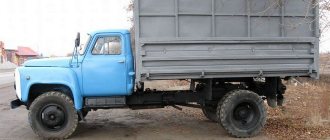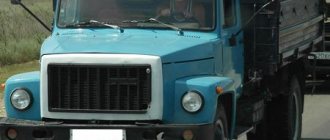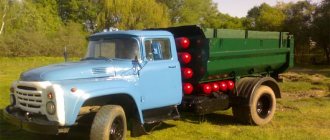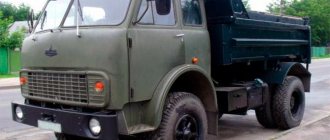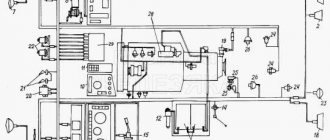History of creation
The new development of Minsk designers differed in many respects from its predecessors, but the main difference, of course, was the new, revolutionary, cabover layout of the car.
The main advantage of the cabover layout is the more efficient use of the length of the vehicle frame. The advantages of this arrangement include better visibility, achieved due to the absence of the engine compartment in front of the windshield.
Experienced MAZ-500 1961 Guards
By the time the first Soviet cabover truck appeared, vehicles of a similar layout had already been produced abroad for quite some time. However, the quality of road surfaces in our country for a long time did not allow the transition to mass operation of such trucks due to the increased load on the front wheel pair. However, by the mid-50s, in the USSR, a significant part of the roads in the European part of the country received a hard surface, which allowed designers of leading Soviet automobile plants to begin developing cabover vehicles.
As you know, for quite a long period, both domestic and foreign automakers preferred to build cars with a classic layout. “Classic” assumed the sequential arrangement of all the main elements and assemblies of the vehicle. A power unit was installed in front, including an engine, gearbox and clutch. Next was the cabin, behind which, with a small gap, a cargo platform was installed.
Another MAZ-500 prototype
This arrangement was not without its drawbacks, the main one of which was the increase in the dimensions and weight of the truck. However, the increase in dimensions did not lead to an increase in the usable area of the cargo body. Thus, the classic layout, in many ways, became the reason for the decrease in the operational characteristics of trucks. This was the main reason that when developing a new model range, MAZ engineers and designers decided to take an innovative path.
First, a half-hood design was developed, when the cabin was extended closer to the front axle and “slipped” onto the power unit, but did not completely cover it. This made it possible to slightly increase the area of the cargo platform and increase the weight of the transported cargo.
However, later the Minsk residents decided to abandon the compromise layout and decided to build a cabover design, completely moving the cabin to the front axle and placing it above the engine. In this case, the increase in the size of the cargo platform was much more noticeable; its capacity was almost one and a half times greater than the capacity of the cargo body of cars with a classic layout. The carrying capacity of vehicles increased by 2 tons at once.
Prototype MAZ-500 dump truck
Among other things, the cabover layout made it possible to improve access to the power unit and reduce the weight and dimensions of the truck. Driving has become easier, but the vibration load on the driver has increased. To solve this problem, softer springs, shock absorbers and seats of a new design were used. It would be worth noting that the new Belarusian truck has become more technologically advanced in production, since there is no longer a need to manufacture dies of complex configurations.
However, at first the new layout had many opponents. The majority advocated the production of semi-hooded machines, justifying this by the fact that it could provide the most convenient access to the engine during repairs and maintenance. However, the arguments of the advocates of the cabover design turned out to be more convincing. They assured that they would be able to develop and build a tilting cabin that ensures safety and reliable fixation even in the event of a collision. The designers also managed to create a successful front axle, the load on which in the cabover configuration increased significantly.
Naturally, there were some troubles - everything new is born in pain! Thus, to some party leaders in Belarus, the idea of installing a cabin above the engine seemed adventurous, as a result of which it was decided to convene the bureau of the Central Committee of the Communist Party of Belarus. The bureau planned to remove MAZ chief designer Vysotsky from his position and severely reprimand the general director of the enterprise, I. Demin, for his democratic style of work.
However, thanks to the Secretary of the Central Committee Filimonov, punitive measures were not put into effect. Before the bureau of the Central Committee of the Communist Party of Belarus, Filimonov visited the plant, where he was shown in detail a truck of a new design. Filimonov was impressed by the new development and noted that the idea, despite its riskiness, was very original, and the new car differed from the old one like day and night. It was this assessment that allowed the plant management to avoid serious troubles.
To begin serial production of trucks of the MAZ -500 family in 1962, a large-scale reconstruction began at the plant. In 1964, the new assembly line was put into operation. The assembly of a pilot batch of trucks began in 1963, and mass production started in March 1965. By the end of the same 1965, the production of trucks of the old MAZ-200 model was completed.
MAZ-200M on which future elements of the MAZ-500 were tested
In order to speed up the development of the new model, the factory workers decided to take a risky step, simultaneously developing, testing and producing the MAZ-500. The components and assemblies designed for the new model were “tested” on serial MAZ-200. Minsk residents received significant assistance in mastering the production of the new car from colleagues from ZiL and GAZ. It was during this period that the “intermediate” models MAZ-200P and MAZ-200M appeared, which were equipped with components and assemblies intended for the new Minsk truck. These models were in mass production from 1962 to 1965, during the period of preparation for the release of the MAZ-500.
A distinctive feature of the “intermediate” models was that each subsequent batch was seriously different from the previous one, since as new components and assemblies were developed, they were installed on the “intermediate” model. First, a new suspension appeared, then the steering mechanism, discless wheels, etc.
Simultaneous development, testing and preparation for serial production made it possible, without stopping the main assembly line of the plant, to enter serial production of the new model in a fairly short time.
However, the timing of the start of mass production depended not only on Minsk residents, but also on related enterprises. Thus, the Yaroslavl Motor Plant was able to put YaMZ-236 diesel engines into production only in 1965. The first prototypes of the engine appeared back in 1958, and serial production of new six-cylinder V-shaped 180-horsepower diesel engines started at the end of 1961. While the new model was being fine-tuned, the YaMZ-236 diesel engine began to be installed on the “intermediate” model MAZ-200P. As already mentioned, the assembly of a pilot batch of MAZ-500 trucks began in 1963, and mass production of the new Minsk truck started two years later - in March 1965.
The MAZ-500 was significantly superior to its predecessor in all parameters and technical characteristics. MAZ designers and engineers arrived at a similar result not only by implementing the idea of a new cabin layout, with its location above the engine, which made it possible, with a general reduction in the length of the vehicle by 290 mm, to install a longer loading platform and increase the load capacity by 500 kilograms. The development of the truck from scratch, without unifying the components and assemblies used in the outdated model, made it possible to introduce a number of technologies and technical solutions that were progressive for that time. These include planetary gearboxes for the rear wheel hubs, discless wheels, telescopic shock absorbers, power steering, and a new forward-tilting cab layout.
The carrying capacity of the MAZ-500 is 7500 tons. The truck was equipped with a powerful four-stroke diesel engine YaMZ-236, allowing it to tow trailers weighing up to 12 tons, while overcoming inclines of up to 14 degrees at a speed of 75 km/h. Fuel efficiency has also improved significantly. For 100 kilometers, the new MAZ consumed 25 liters of fuel, which is 10% less than the fuel consumption of the MAZ-200.
In 1970, the MAZ-500 was modernized, the updated model received the MAZ-500A index. The engine has not been modernized, but the gearbox has been replaced with a more advanced five-speed unit. Thanks to changes in gear ratios, both the gearbox and the rear axle, the traction qualities of the truck have improved. Along with the new gearbox, the car received a new double-disc clutch, as well as radial tires of size 11.00-20″.
After modernization, the maximum speed of the MAZ also increased, reaching 85 km/h. A number of design improvements made it possible to increase the load capacity to 8 tons. At the same time, the curb weight of the car increased to 6600 kg. After modernization, the dimensions of the truck also changed somewhat. Its length decreased slightly, reaching 7140 mm, and its width, in accordance with European standards, was increased to 2500 mm.
However, let's go back to the distant 1958, when the first prototypes of the MAZ-500 truck were assembled. During testing, the first copies revealed many shortcomings that required improvement and immediate elimination. So, initially the designers envisaged equipping the truck with a new pneumatic-hydraulic braking system, but due to the complexity of the design, this idea had to be abandoned and returned to traditional pneumatic brakes. The interior of the new cabin also generated a lot of complaints.
When assembling the first prototypes, components and assemblies of the serial MAZ-200 were used. Thus, the cars were equipped with a four-cylinder two-stroke YAZ-204 engine; naturally, there was no power steering. The cabin design was also still far from the final version, which appeared several years later.
On the occasion of the Great October Revolution, the first six assembled and painted trucks were presented to TASS photo reporters, and after filming for the photo chronicle, they went for the first run tests. Tests under real operating conditions revealed a whole bunch of design and technological shortcomings and, at the same time, proved the promise of a new vector for the development of heavy diesel trucks. In 1959, prototypes were demonstrated at VDNKh. In 1961, comparative tests of the MAZ-500 and the transition model MAZ-200P were carried out. Their results turned out to be predictable - the MAZ-500 surpassed its predecessor in almost all respects.
In 1961, a new experimental workshop was launched at the Minsk Automobile Plant, which made it possible to expand the scope of work. By the summer, a pilot batch of 122 trucks of two basic types had been assembled. The cars were sent for testing to various automotive fleets of the USSR. The motor rally Minsk - Moscow - Leningrad - Riga - Minsk also caused a great resonance at that time. However, the necessary information about the advantages and disadvantages of the new model was given to engineers and designers not by cars participating in exhibitions and car rallies, but by hard workers operating in the extreme conditions of the Far North, on construction sites, quarries, and timber industry enterprises.
In addition to flatbed trucks and dump trucks, the pilot batch included a MAZ 504 truck tractor and a MAZ-509 all-wheel drive timber truck. Single copies of these cars were assembled in the experimental production workshop.
By 1965, there were already over two hundred units of experimental Minsk cabover trucks running on the roads of the USSR. They were shown quite often in newsreels, and pictures of the trucks were published in the press. At the same time, in reference books the MAZ-500 was already indicated as a mass-produced model.
The fact that the best-equipped pilot production facility in the Union was opened at the automobile plant certainly produced results. The average operating speed of experimental trucks increased by 15% while the cost of transportation decreased by 20%. A significant increase was also recorded in the reliability indicator - the mileage without major repairs for new products was 120,000 kilometers, which was one and a half times higher than the MAZ-200.
The design of the 500s included power steering, a spaced final drive with wheel planetary gearboxes, a front suspension with telescopic hydraulic shock absorbers, discless wheels, and an all-metal cab with a forward tilt mechanism. In the basic version, the weight of the MAZ-500 was 14.2 tons, the truck reached a maximum speed of 75 km/h, consuming 25 liters of fuel per 100 kilometers.
By 1965, the plant’s design team under the leadership of chief designer M.S. Vysotsky did a titanic job, bringing it to its logical conclusion. In March 1965, the first production truck MAZ-500 rolled off the main assembly line of the enterprise. It took the factory workers seven years to go through the difficult path from the first sketches of the designers to mass production. The work of the team was appreciated; at various all-Union exhibitions of motor vehicles, the MAZ-500 was repeatedly awarded the highest awards.
In 1966, the Minsk Automobile Plant was awarded the highest state award of the USSR - the Order of Lenin - for the successful implementation of plans, the development of new vehicle designs and their introduction into production. 4 years after the start of mass production, the 75,000th MAZ-500 rolled off the assembly line of the plant. By 1968, the plant reached its designed production capacity equal to the annual production of 24 thousand cars.
MAZ 500 series: Soviet long-range fighter
In order to create a long-haul truck, you must first make it somehow. Only then, through trial and error, arrive at the intended goal. Which, in fact, was done 50 years ago at the Minsk Automobile Plant
Sergey Zhukov
In 1965, serial MAZ-500 trucks began rolling off the assembly line of the Minsk Automobile Plant. Progressive in all respects, the vehicle had a layout with a cabin over the engine, an optimal ratio of payload to the truck’s own weight, and good fuel efficiency due to the installation of a YaMZ-236 engine with a power of 180 hp. With. At the same time, the plant is assigned a role in the production of heavy diesel trucks capable of operating on first category roads, allowing an axle load of 10 tons, with the ability to tow a trailer. This fully complied with the requirements of GOST 9314-59 for trucks falling into group A with a permissible load on a single axle of up to 10 tons, and on a twin bogie - up to 18 tons.
Let’s ignore the difficulty with which this machine made its way onto the assembly line; so much has already been written about this; let’s focus on two key points that influenced the further course of events.
First. This is what Mikhail Stepanovich Vysotsky, who held the post of chief designer at that time, set the goal of launching a modernized car into series every five years, and a new model every ten years. At the same time, his words did not differ from his deeds. The MAZ-500 had just entered the production line, and the factory workers were already beginning to figure out what they would end up with in the near future. To begin with, it was planned to modernize the produced model based on the results of feedback from operators. So, already at that time, the plant’s portfolio contained outlines of the future MAZ-500A.
The second, perhaps the most important circumstance. The chief designer understands that transportation volumes are constantly increasing, and with them the need for rolling stock, and as a result, there will be an additional need for drivers. However, he is not satisfied with the extensive course of events. He sees a solution to the problem in the creation of trucks and road trains with increased carrying capacity. It is with their help that transportation efficiency can be ensured. Therefore, in the strategic plan, the emphasis is on them.
And by the end of 1965, not only a promising type had been developed, but also prototypes of road trains with increased carrying capacity had been created. In addition to them, there were also search models.
The first type included a MAZ-510 heavy-duty truck for working with a trailer, a MAZ-504V two-axle truck tractor, a MAZ-516 three-axle heavy-duty truck with a third supporting rear axle, also for working with a trailer; a three-axle truck MAZ-514 for working as part of a road train and a three-axle truck tractor MAZ-515 for working with a semi-trailer. Now let's talk more about the models themselves.
MAZ-510
MAZ-510 with trailer MAZ-886 (1965)
This is a flatbed truck with increased carrying capacity for working with the MAZ-5210A (5205A) trailer on intercity routes. It should be noted that experimental vehicles already existed under this index, in particular dump trucks with a simplified single-seat cabin, which, however, never went into production. The MAZ-510 is often confused with another representative of the large Maz family - the long-wheelbase modification of the MAZ-500G. The cars did not differ so much in their platforms as they had different weight categories. MAZ-500G (8 t capacity) was intended for transportation of long cargo or use as a chassis for the installation of various superstructures (at least one of its varieties is known - the CHAR-3-500G refrigerator). MAZ-510 (load capacity 9 tons) was assigned to work as part of a road train on intercity routes with semi-trailers using dollies: two-axle MAZ-5210A and three-axle MAZ-5205A. In the first case, the road train was designed to transport 24 tons (9+15), in the second - 27 (9+18). At the same time, the car was supposed to be equipped with an engine with a power of 200 to 240 hp. With. Since there was not yet a serial unit of such power in sufficient quantity (the 240-horsepower YaMZ-238 was just being introduced into production, and besides, there were plenty of other contenders for it), the truck was shelved. The MAZ-510 can well be considered the prototype of the second wave of modernization - MAZ-53352.
MAZ-53352 with trailer MAZ-8378 (1973). It was in this form that the car hit the assembly line.
Only by 1973 did the MAZ-53352 acquire real features. The truck is equipped with a YaMZ-238E engine with a power of 265–270 hp. pp., 8-speed gearbox and a MAZ-8378 trailer specially designed for it. However, it would be another three years before this long-haul truck would hit the assembly line (February 1976). And a year later, a cab from the MAZ-5335 family will be installed on the truck. Subsequently, it will be replaced by the MAZ-53361, but now this niche is filled by the MAZ-5340 family.
MAZ-53352 with trailer MAZ-8378 (1977)
MAZ-516
Since further increases in carrying capacity involved the use of vehicles with added axles, three-axle vehicles were included in the type. However, at the first stage, difficulties arose with them again, mostly of an “undercover” nature. Opponents referred to the fact that the plant would not be able to take the new direction, and that triaxles were made by KrA3. Nobody took into account that an off-road KrAZ is one thing, a long-haul truck is completely different. We managed to defend the direction, but it developed with great difficulties.
The first step was the use of a third trailing axle on MAZ trucks in order to increase load capacity. The MAZ-516 became just such a truck. In its original version, it was designed to transport 15 tons. As part of a road train, the carrying capacity increased to 24 tons through the use of a MAZ-886 trailer (load capacity 9 tons). In order to maintain the necessary operating parameters, the car was also supposed to be equipped with a 200–240 hp engine. With.
MAZ-516 (1965) with lowered and raised trailing axle
At the same time, the mass utilization factor, that is, the load capacity per ton of its own weight, was 1600 kg. A very worthy indicator for the Soviet automobile industry of that time. The third trailing axle made it possible to better utilize traction force, increase the vehicle's load capacity and at the same time reduce the axle load, which was important for preserving roads. The axle was equipped with a hydraulic lifting mechanism with pneumatic control from the cabin. Since the carrying capacity has increased, and therefore fuel consumption, an additional fuel tank has been provided. At the same time, another important task was solved - saving fuel and tires when driving empty, by hanging the rear axle.
The first samples were collected already in 1965. In January of the following year, the plant began interdepartmental testing of this truck. Most likely, vehicles with YaMZ-236 engines were used for testing. There were no others, given all the conflicts happening around. Naturally, finishing the truck took some time. Only by the end of 1968 were all the comments eliminated, and the vehicles again passed interdepartmental tests. 1969 was marked by the completion of acceptance tests and the assembly of the first industrial batch.
Since the power of the YaMZ-236 was clearly not enough to work with a trailer, the first MAZ-516s were operated as “singles”, first with a carrying capacity of 14 tons, and then 14.5. A year later, the MAZ-516A appeared, since a modernized model of the base MAZ-500A truck was put on the assembly line, and the pre-production MAZ-516 was already unified with the new model.
MAZ-516A (1970)
There was only one small thing left to do - install a new cabin. As you can see, Vysotsky kept his word - five years later a modernized model appeared.
The 240-horsepower MAZ-516 engine with a carrying capacity of 16 tons, as well as the ability to work with a trailer, only gained in June 1973. Then the first industrial batch of MAZ-516B was produced. The MAZ-516 will undergo its last modernization in 1977, when the MAZ-5335 cab is installed on it.
MAZ-516B with trailer MAZ-886B (1973). The first industrial batch was produced in this form.
A small incident arose from a photo of the first MAZ-516. Most likely, it was mistakenly passed off as a full-fledged three-axle MAZ-514 for only one simple reason - the third axle was not hung. No one paid attention to the fact that the first MAZ-516 had reduced sides of the cargo platform, while all MAZ-514 were initially equipped with full-fledged onboard platforms.
MAZ-516B (1977)
The MAZ-516B was subsequently replaced by the MAZ-6301, but now the MAZ-6310 is present in the factory program.
MAZ-520
But there were other variations on the triaxial theme. For example, a search model of a truck tractor for working with a semi-trailer (MAZ-5205) with a total weight of up to 25 tons with two front steered axles. We must pay tribute, it was a fashionable trend in those years to create trucks with two steered front axles. It did not bypass MAZ either. This truck tractor, according to the developers themselves, was copied from the Mercedes-Benz LP333 and the like.
The purpose of creating the MAZ-520 was to increase the load capacity of the road train without increasing the load on the standard serial front axle. However, with a permissible axial load of 10 tons, it was not possible to significantly increase the load on the saddle, while the design became significantly more complicated compared to the simpler, but also less load-bearing MAZ-504. There were other negative aspects regarding weight distribution and handling.
After a series of tests, the factory workers abandoned this decision as unpromising and were right, since this trend quickly faded away in Western Europe, at least in the form in which it existed at that time.
MAZ-516 and MAZ-520 were only the first steps on the path to full-fledged three-axle heavy-duty trucks. By the end of the same 1965, they were also created: a car with an onboard platform and a truck tractor.
The three-axle design with two drive axles in the rear bogie was perfectly suited to Russian reality with its disgusting roads and low branching, which during the tests only convinced the developers of the correctness of the chosen path.
MAZ-514
The MAZ-514 onboard main tractor for working with the MAZ-5205A trailer was a three-axle truck with a bogie drive on both axles. As part of a road train, it could transport up to 32 tons (14+18) with a total weight of 48.7 tons. Moreover, the middle bridge was walkable. Initially it was assumed that the road train would be equipped with engines with a capacity of 240–270 hp. With. However, Yaroslavl engine builders were late in fully developing the YaMZ-238, and the 236th was completely ineffective for this road train.
MAZ-514 with trailer MAZ-886 (1965)
But it seems that in January 1966, a car with just such an engine was tested. And with the suspension it was not so simple. The rear bogie originally had Timken/Hendrikson type suspension. It turned out to be frankly raw.
At the turn of 1968–1969. The car has been significantly redesigned. First of all, the chassis was reconfigured. If at first the arrangement of fuel tanks, batteries and a spare wheel was akin to the MAZ-500, then on the cars of the new series they were swapped. By the way, this fully applies to the chronology of the creation of the MAZ-516. Subsequently, this rearrangement will take place more than once.
MAZ-514 after chassis reconfiguration (1969)
By 1971, the final decision on the MAZ-514 had been reached. The car already had a YaMZ-238 engine with a power of 240 hp. s., but it was still not enough for full-fledged work as part of a road train. The load capacity of the road train had to be reduced to 23 tons (14+9). Among the significant differences of the truck, it is worth noting the presence of an 8-speed gearbox, a through middle axle and a balancer suspension in the rear bogie.
MAZ-514 (1973). This is how carriers saw it after it was launched into series
By the time the first industrial batch was released in 1974, it was still possible to equip it with a more powerful supercharged engine YaMZ-238E with a capacity of 270 hp. With. Most likely, what this truck did not see was the MAZ-5335 cab. The plant was already full of the MAZ-5336 family.
One of the MAZ-514 variants with a MAZ-5205A semi-trailer on a dolly (1974)
After some time, the MAZ-6303 appeared in the production program, now it is replaced by the MAZ-6312.
MAZ-515
By and large, the same can be said about the MAZ-515 long-haul truck tractor, since it underwent the entire test cycle together with the MAZ-514.
MAZ-515 with an experimental semi-trailer MAZ-941 (1965)
The road train was designed to transport 30 tons with a dead weight of 46.7 tons. Initially, it was supposed to use a 2.5-PP three-axle semi-trailer, but the vehicle was sent for testing with a prototype of the MAZ-941 semi-trailer. The engine for this tractor was set at 320 hp. With. But it’s one thing to set parameters, another thing to have the necessary units available. Most likely, only in the early 1970s the car acquired real shape, however, just like the MAZ-514.
By the time the first industrial batch was released, already under the designation MAZ-515B, it was equipped with a YaMZ-238N supercharged engine with a power of 300 hp. With. This was somewhat less than originally planned. Therefore, the load capacity of the road train was reduced to 25 tons.
MAZ-515B with MAZ-941 semi-trailer (1973). This is how the car arrived at the carriers.
Despite the fact that the vehicle began to be mass-produced, work continued on layout solutions (fuel tanks, batteries, remote air filter, receivers). We tried to play with installing newfangled lighting equipment, equipping with air conditioning, etc. In 1974, at an exhibition dedicated to the 60th anniversary of the domestic automobile industry, a tractor with a cab from the MAZ-5335 was shown. And this is three years before the MAZ-5335 family was put on the assembly line!
One of the MAZ-515B variants (1973)
By the way, the long-range “500th” has also significantly improved the cabin interior. New instrument panel, sprung, with seat height adjustment; soft upholstery with thermal and noise insulation, sun visors, a dining table, window curtains, sleeping places with individual lighting devices, a heater, handrails - everything was designed to provide comfortable conditions on long trips.
“Exhibition” MAZ-515B with a MAZ-941 semi-trailer (1974)
With the transition to the new MAZ-5336 family, the MAZ-6422 subsequently entered the production line, now it has been replaced by the MAZ-6430.
MAZ-504V
While the road network, or rather its quality, left much to be desired, objectively three-axle vehicles were preferable. But with the improvement of the situation, as well as access to international transportation, the need for two-axle mainline tractors arose.
MAZ-520 with an experimental semi-trailer MAZ-5205 (1965)
The initial type of such a vehicle was provided - MAZ-504V with a MAZ-5205 semi-trailer with a carrying capacity of 18 tons. It was supposed to be equipped with a YaMZ-238A engine with a power of 215 hp. With. However, it is unknown whether such a car was assembled in 1965.
MAZ-520 during road tests (1965)
Only in 1969 did this index appear again in factory documentation. The load capacity of the road train was increased to 20 tons, simultaneously installing a more powerful engine - YaMZ-238 (240 hp). Various tests lasted about three years, and only at the end of 1972 the road train entered the assembly line. The first industrial batch was released. However, it was not destined to work on international routes - it lacked both power and carrying capacity. Everything was limited to intercity transportation.
In 1977, the tractor was modernized, at the same time installing a cabin from the MAZ-5335 family. During the same period, there was an attempt to improve the characteristics of the tractor by developing the MAZ-5428. The successor had higher power due to the installation of a YaMZ-238P supercharged engine with a power of 280 hp. With. and an 8-speed gearbox. The load on the fifth wheel coupling was also increased. The total weight of the road train increased to 33 tons. But this did not save the situation. The car remained experimental.
MAZ-504V with semi-trailer MAZ-5205A (1970)
In addition, work on the new MAZ-5336 family was in full swing at the plant. A year later, the new generation three-axle highway MAZ-6422 appeared. The two-axle model MAZ-5432 was also on the way, and it actually ruined the MAZ-5428. By the way, this branch can well be called the pedigree of the current MAZ long-haul tractors represented by the MAZ-5440 model.
It's time to sum it up. The chief designer of MAZ, Mikhail Stepanovich Vysotsky, practically kept his word, naturally, adjusted for the stagnation that had occurred in the Soviet economy. He and his team created a main line at MAZ 50 years ago and exactly 5 years after the MAZ-500 was put into production, they modernized it (MAZ-500A). And although in 1975 we did not see a new model (some of the prototypes of the MAZ-5336 family are dated 1973), in 1977 the transitional model MAZ-5335 appeared on the conveyor, and a truly new car in the form of the MAZ-6422 appeared in 1978 began her run.
MAZ-504V with semi-trailer MAZ-9397 (1977)
And then the school began to work. Thanks to her, Perestroika and a number of other prototypes appeared. Starting with the MAZ-500, Minsk residents have created three generations of cabins, although not world-class, but quite decent, and this is worthy of respect.
Read on topic: unknown ZIL-130 - plastic truck >>>
The editors recommend:
Why do piston rings stick and how to prevent it?
A traffic police officer searched my car: did he have the right to do so?
Russians may be left without foreign cars: Western automakers have stopped supplying cars to our country
A ship that was transporting cars to Russia was detained in France
Half of the car factories in Russia have closed
News Media2
Discussion Cancel
Further development of the 500 series
In terms of its technical characteristics and parameters, the MAZ-500 was not inferior to its foreign analogues, and in such important indicators as maximum speed and maneuverability, it even surpassed them. As for domestic analogues, the MAZ-500 was significantly superior to them in its efficiency.
However, it was not without its drawbacks. The overall width of the truck was 2650 mm and exceeded European standards of 2500 mm. This did not allow the trucks to be operated on international routes. In addition, the gear ratios of the gearbox were not entirely selected, and the engine power did not allow the vehicle to be used for long-haul transportation. Taking into account operating experience and in order to eliminate shortcomings, MAZ designers began developing a modernized version of the MAZ-500.
The overall width was brought into line with international standards, the gearbox ratios were adjusted, which made it possible to increase the maximum speed of the truck to 85 km/h. The wheelbase has also increased by 100 mm, and the load capacity has reached 8 tons. The modernized version began to be mass-produced in 1970 under the designation MAZ-500 A. The family of modernized trucks also included MAZ-503A and B dump trucks and MAZ-504 A and B truck tractors.
MAZ 500A
In 1970, a large group of employees of the renowned enterprise was awarded the USSR State Prize for the successful development and introduction into production of a new family of domestic heavy-duty trucks.
In 1968, Minsk automakers began preparing for serial production of three-axle trucks MAZ-516 and industrial timber trucks MAZ-509. To master the production of these cars, it was necessary to equip the workshops with additional metal-cutting machines and machining centers.
Along with modernization and improving the quality of products, the plant developed and introduced production technologies that were modern at that time. The machine park was significantly updated, new modular machines and machining centers were introduced.
MAZ-500S - modification for the far north
Since the start of serial production of the MAZ-500, the company’s specialists have been constantly monitoring their products and monitoring the results of vehicle operation in the country’s fleets in order to identify shortcomings and further improve the quality, reliability and durability of vehicles.
As already noted, since 1970 the plant switched to producing the modernized MAZ-500A family. Among other things, the modernized version of the trucks has an increased mileage before the first major overhaul by 40 thousand kilometers. Externally, the modernized truck was practically no different from its predecessors. Perhaps the only external difference was the updated, “checkered” radiator grille.
The next modernization of popular trucks was carried out six years later, in 1976. Then the plant began serial production of the model under the symbol 5335. This time, MAZ designers paid more attention to improving the “appearance” of the model. The truck received a new cladding and bumper with lighting technology integrated into it. The cabin interior has been improved, and the wooden loading platform has been replaced with a metal one. The mileage before major repairs increased to 300 thousand kilometers, and the labor intensity of maintenance was reduced.
In 1977, new standards for the placement of lighting equipment on trucks were introduced in Europe. This forced MAZ designers to quickly integrate the headlights into the bumper. To prevent the car from looking “blind,” the designers developed a new, more aggressive radiator grille. In addition to appearance, this also improved engine ventilation. In the place where the headlights were previously located, direction indicators began to be installed. Decorative turn signal trims, which stylistically complement the radiator grille, visually enlarge the grille, but its area remains the same.
continuation of the 500 MAZ-5335 series
After the modernization of 1976, cars began to be assigned indexes according to the new system adopted for freight vehicles. Thus, the basic version, which previously bore the index MAZ-500A, received the new designation MAZ-5335. Other cars in the family received similar indices. At the same time, the range and typology of trucks has not changed, although improvements have been made to the design of many of them.
The “500th” MAZ can rightfully be called the brightest page in the entire history of the Minsk Automobile Plant. It was this model that became the calling card of the enterprise for many years and determined the concept of subsequent generations of Minsk trucks. Even today, when ultra-modern models with elements of Western gloss come off the MAZ assembly line, upon careful examination you can see the features of the glorious “grandfather” in them.



